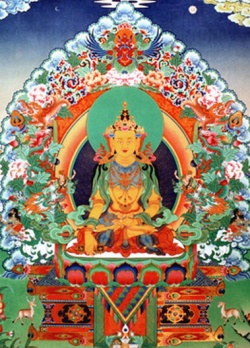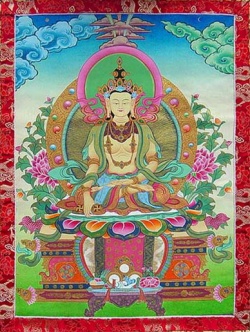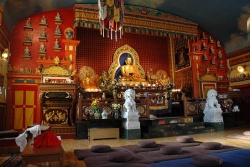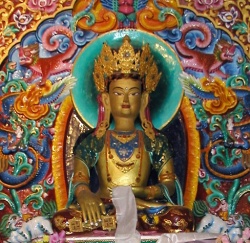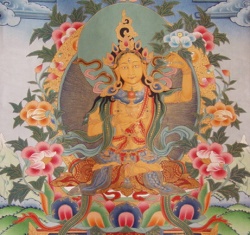Deities, Spirits, Gods & Goddesses
SOUL.........(LA, bla)......."The soul is the most subtle balance of the five elements in an individual. In order to repair the damage or loss you do shamanic ritual of "Soul Retrieval"...which is like charging one battery from another battery. The other battery is not losing energy....... Imagine that you are receiving what looks like a "tigle".....Most of the tigle is white but it has a reflective red colour in it. The more precisely you imagine, the more effective the result....When you retrieve these bolts of light they go into the life force, the White A and the A dissolves into the person........If it is soul, it is NI where you retrieve those qualiities"......Every life force has a soul.....we are asking to receive energy to heal our soul. There is a Tibetan term that refers to the brightness of the life force........Follows with an important description of the Five Tsa Lung exercises............Tenzin Wangyal (The Five Elements in Tibetan Shamanism and Tantra.......1998)
"The Tibetans have very complicated linkages and overlappings among the protector gods of the person, the protectors gods of lineages (male, female, maternal uncle) and the different masters of the place or territory." (Blondeau: 1996..pg ix)...
"It is difficult to relate to enlightened energies if they have no form or ground for personal communications. One should remember that the mind that perceives the deity and the deity itself are not separate."....(Sogyal: 1992...pg 285)...
"In Shinto, the fact that the gods are so numerous means that the world is that much richer."...(Jinja: 1958...pg 15)
"In the non-theistic discipline of Buddhism, we do not glorify 'that' because we want to confirm 'this'...We are not denying God, but we are simply trying to approach reality as simply as possible."..(Trungpa: 1996..pg 33)....
"In Shinto, people recognize that there is an innate relationship between themselves and a certain deity, and that they are by heredity the worshipper of it. Belief is not compulsory, rather the elements of pride and joy enter into it."...(Jinja: 1958...pg 28)...
"The wrong way to take refuge involves seeking shelter--worshipping mountains, sun gods, moon gods, deities of any kind simply because they would seem to be greater than we."...(Trungpa: 1973..pg 27)...
"Let us believe that such things do exist."...(Trungpa: Poem in First Thought, Best Thought...1983..pg 125)...
DRALA....There are two different Tibetan terms: Drala (sGra bla) and Dralha (dgra lha)... Whereas "la" is translated variously as "life force, spirit, soul, vital essence" and lha as "god". ..
.."Drala could almost be called an entity. It is not quite on the level of a gods or gods, but it is an individual strength that does exist. Therefore, we not only speak of drala principle, but we speak of meeting the dralas. The dralas are the elements of reality...anything that reminds you of the depth of perception." (Trungpa:1984..pg 105)... drala (god of war and patron of warlords and warriors) Trungpa:1978...
sGra ....sgra: sound, voice, cry....sgra'i lha: sound deity...bso sgra: war cries....seng ge'i sgra: the lion's roar..... ku bswo cha sgra: war cry...sgra od zer: sounds, lights, rays...See Bibliography: A. Clemente: "The sGra bla, Gods of the Ancestors of gShen rab mi bo according to the sGra bla go bsang from gZi brjid" in "Tibetan Studies, Proceedings of the 6th Seminar of Tibetan Studies", Fagerness: 1992...."Drala spelt sgra bla, which means la of sound, where la (soul or vitality) stands for a type of individual energy that is endowed with protective functions" [Norbu:1995]....
sGra-la...."the spelling sgra-la (la of sound) is based on a very deep principle. Although not visible, sound is perceived through the sense of hearing and is linked to the Cha (the individual's positive force, the base of prosperity), and wangthang (ascendancy-capacity, both aspects related with the protective deities and entities since birth. Sound is considered the foremost connection between the individual and his la. This is the meaning of the word sgra-la." (Norbu: 1995...pg 62)...
dGra ...dgra: enemy, foe, adversary, opponent...."He is the drala (dgra bla) who extended the power of Shang Shung"..(Mipham text in Norbu: 1995, pg 58)...dgra lha: "foe-god" (Hoffman: 1975..pg 97)... dgra lha: protective warrior god..(Lopez: 1997..pg 4)...dgra-lha (enemy god): "the enemy who prevents man from being potent" [Paul:1982].... dgra-lha (warrior gods) [Stein:1972].... dgra-lha (enemy god): King Gesar is called "the King Gesar, the dgra lha of Zhang Zhung." [Nebesky:1956..pg 318]....dgra lha (war gods) [Kornman:1997]....drala (dgra bla) literally "above the enemy" Beyond aggression. Divine principle that protect against attack or enemies. (Nalanda Translation Committee:1997]...dgra dul: to vanquish the opponents, enemies...dgra lha: war god, deity of war....dgra bla: warrior spirit...norbu dgra'dul: Gesar......Zhang Zhung Gi Dgra Lha: war goddess of Shangshung. "Great Glacier Lady of Invincible Turquois Mist"...
"Jamgong Kongtrul the Great made things more curious by writing in his work: 'dgra-bla'."..(Karmay: 1975..pg 218)...
Other spellings and meanings found: drabla (enemy god) [Samuel:1993].... drapla, (sgra bla: enemy god) Kvaerne in Lopez:1997....
LHA DEITIES
LHA..."lha is a term used to designate any type of deity in general, and also as the name of a specific class. The lha dominate higher celestial space."..(Norbu: 1995..pg 242)...
PHUG LHA..."Tibetan deities of the home. Reside with the family and protect all the members. Govern the cha and yang of the home and defend them against damage. They may be disturbed if a tantric Buddhist or Bon practitioner comes into the kitchen, as their protective deities usually belong to the class of rGyal po or bTsan, which can easily conflict with the Phug lha. Then it is necessary to perform a bSang rite to restore harmony." (Norbu: 1995..pg 251)...
LHA DEITIES..."the lha is about to enter the subject's body and wants to communicate through this vessel. The body is the medium for the deity. In order for the lha to settle in the human body, the mind of the subject must be completely void. Once in the lha-state, the human becomes a lha, the deity himself. Since modern Western culture does not believe in spirits and deities, this bodily expression of a spiritual manifestation is regarded as a 'psycho-physical transformation of consciousness'. (Brauen: 1993..Schenk)...
FIVE DEITIES OF THE INDIVIDUAL...The Tibetan text: "Offering to the Five Deities of the Individual" by the Fifth Dalai Lama (1617-1682) A text discussing the five deities of the individual that live with each person, including the dralha that resides on the right shoulder...."the personal protective deity of dGra lha occupies the right shoulder." (Nebesky: 1956..Pg 318)...."the gowe lha are a standard set of five gods born at the same time as a child: Sog-lha (god of life with its seat in the heart)...Pho-lha (male god in the right armpit)...Mo-lha (female god in the left armpit)...Dralha (enemy god at the right shoulder)...and Yul-lha (locality god at the crown of the head." (Samuel: 1993..pg 187)..."the srog-lha resides on the head...the pho-lha mi-rdzi on the right shoulder...the ma-lha bu-rdzi on the left shoulder....the sGra-bla in front of the head...the zhang-lha at the back of the head"..(Karmay: 1975...pg 193)...
SHENLHA OKAR...Pictorial descriptions and information on the Tibetan deity Shenlha Okar as appears in the recent book by Per Kvaerne, "The Bon Religion of Tibet" (Shambhala Publications, 1996) "From the white pure light arises the deity Shenlha Okar at the center of the mandala."(Wangyal:1993 p147)..."Kungtuzangpo gave the teachings to Shenlha Okar who passed them to Shenrab Miwo who taught them in Zhang Zhung. (Wangyal:1993 pg 210)..."The colour of his body is like the essence of crystal." (Paul:1982) (Hoffman:1979,pg 105) (Kvaerne:1996, pg 26)
PHO LHA..."God of the male lineage"..(Blondeau: 1996..pg viii)...."The Male (tutelary) God, Pho Lha, is the personal protective deity of a single given descent line. As long as there is only one clan living in an area, a Pho Lha cannot be distinguished from a Yul Lha in his actions." (Blondeau: 1996..pg 123)...
YUL LHA..."The most intriguing case of transfer is at Mont-Blanc in Switzerland with the new abode of a local Tibetan god which has followed the Tibetan community." (Blondeau: 1996...pg x)...."The Yul Lha is responsible for all the lines of descent. The question of transition from pho lha to yul lha..." (Blondeau: 1996..pg 123)..."the mountain deities known as 'owner of the base' (gzhi bdag) or 'deity of the local territory' (yul lha)...(Blondeau: 1996..pg 59)...
KYE LHA...(skyes lha)...the god(s) of birth....
TSHONG LHA...the deity of trade, has an elephants head and resembles the Indian god Ganesa." (Nebesky: 1956..pg 331)...
"dGe LHA: the god of happiness"..(Nebesky: 1956..pg 333)...
CANG SENG..."a group of lam lha, 8 males and 1 female."..(Nebesky: 1956..pg 334)...
WEALTH DEITIES
WEALTH DEITIES...kordre (dkor 'dre) wealth spirits...
"The Zijid explains that when someone is afflicted by poverty it is necessary to increase the cha and the yang." Rituals are described to summon the cha and yang present in the universe. (Norbu: 1995..pg 72)....
"In many Tibetan houses, a white dgra lha mask is always Hung to insure good luck and prosperity for the family. A thangka showing the nine dgra lha is also Hung." (Nebesky: 1956..pg 335)...
DZAMBHALA......wealth deities......Energetically they are different spirits. Either they are enlightened or they are not completely enlightened yet are still very powerful.....When you invoke these spirits they support you....Tenzin Wangyal (The Five Elements in Tibetan Shamanism and Tantra.......1998)
"NOR LHA: the deity of wealth...dwells on a lotus; he accumulates jewels." (Nebesky:1956..p 332)....
"rNAM THOS SRAS" rides on a white lion. He amasses gold and silver." (Nebesky: 1956..pg 332)...Vaisravana (rNam thos sras): the God of Wealth....."Namse (Rnam-thos-sras) a manifestation of Kuvera, the God of Wealth." (Paul: 1982..pg 111)....
"CHUGLHA: the god of wealth wears a golden per over golden armor. Carries a multicolored victory banner in his right hand. He vomits gems." (Trungpa: 1978...pg 224)....
"KLU BTSAN is the source of wealth and thriving of the country. He is one of the four ministers of sMug po rong." (Blondeau: 1996..pg 125)...
GROGS LHA...deities that enhance income and the economy. Deities of grain.
KUBERA: "in the north is occupied by Kubera, the owner of treasures (gTer gyi bdag po), who commands the yaksas." (Nebesky: 1956..pg 333)..."Kuberas refer to a class of celestial beings. According to ancient mythology, they are the gods of wealth who reside on the base of Mt Sumeru. Their chief is Vaisravana. He is usually depicted wearing warrior's armor, seated on a lion, and is yellow in color." (Lhalungpa: "Mahamudra"...1986..pg 444)
RIGDEN KINGS OF SHAMBHALA
RIG....In Ancient Persia, the Indo-European words for King (Sanskrit: rajan...Latin: rex...Old Iranian: Rig...Gallic: rix)(Lincoln: 1981..pg 35)..means not only to regulate and direct in a manner that is right but also to shine with luster (Sk: raj). The divine right of the king was derived from the brilliance (cihr) and sovereignty (sahr) of the sky itself; therefore it was fitting that his palace should be in the 'padak' of the sun and that his 'tiara' should resemble the surrounding sky-wall and rays of the sun." ..(Campbell: 1968..pg 101)........
DEN...."In ancient Persia, 'Den' was the Old-Iranian term for wisdom. 'Den' operates as a creator within the limits of cyclic time and the motions of matter and space. 'Daena-Den' was an intermediate Creator between space and time. 'Den' reveals the Expanding (Spenta) and Good (Vohu) Mind (Mainyu) all that happens until the 'Fraskart' (The final restoration of the world)" ..(Campbell: 1968..pg 119+)
Kalkin (Tib: rigs ldan): chieftan, governor who holds the lineage, "one who bears the lineage"
"The imperial rulers of Shambhala, who are called the Rigden Kings, are inhabitants of the cosmic mirror. They are referred to as ultimate drala." (Trungpa: 1984..pg 174)...
The 7 Shakya Kings and the 25 Kulika Kings (Kalki)...
Rigden Time: "not solar days of 24 hours, but completely beyond all limits of time and space. 'Meditation days' refer to the length of time one is able to rest undistracted in the nature of mind." (Sogyal: 1992..pg 279)....
"Only 25 kings of Shambhala are specifically mentioned in the Wheel of Time Tantra and the names of their descendants are not given." (kongtrul: 1995..pg 46)
"the country of Sambhala, protected by the 32 chieftans." (Kongtrul: 1995..pg 153)...
1. Dawa Zangpo (Sucandra, Zla-bzang, zla ba bzang po)..Dawa Zangpo was the first of the seven "SHAKYA" kings of Shambhala.(Bryant:Wheel of Time Sand Mandala)........Sucandra died two years after receiving the Kalachakra teachings. The six religious Kings of Shambhala were descended from the Shakya clan......"father of Sucandra was Shakya Shambha" (Bernbaum:1980..pg 285).."On the pleasant bank of the Candrabhaga, a city named for Sambha is situated"...(Campbell: 1978...pg 236)....."King Dawa Zangpo (Sucandra) (Zla-ba bZang po) (Lord of Humanity)..(Kongtrul: 1995..pg 276)...
7. "Hidden Omnipresent One (Khyab jug sbas pa) was the 7th Chieftan of Shambhala. Fifty One years after he ascended the lion throne of the Kingdom of Shambhala, the 1800 year period of barbarism will begin."(Kongtrul: 1995..pg 163)...."the 7th King of Shambhala was called King Yashas, 'the Renowned', predicted the coming of the 'barbarian dharma' after 800 years." (Bryant: 1992..pg 71)...
8. (2nd Kulika King): Padma Karpo (Pundarika) composed the most famous exposition on the Tantra. In 624 A.D. a Moslem invasion weakened the Kingdom." (Geoffrey Hopkins: 1985..pg 60)...."the 8th King of Shambhala, Pundarika, was the son of King Yashas."..(Bryant: 1992..pg 71)...
15. (7th Kulika King): Khyabjuk Bepa..."the 7th King of Shambhala, Khyab-jug sbas pa (Hidden Omnipresent One)"..(Kongtrul: 1995..pg 274)...
16. (8th Kulika King): "the 8th King of Sambhala, 'Manjusriyasas ('jam dpal grags pa) was the first to be called Rigden." (Kongtrul: 1995..pg 273)....Jampa Trakpa ('jam dpal grags pa...Kulika Manjushrikirti) initiated 35 million seers into the Kalachakra mandala.(Geoffrey Hopkins: 1985..pg 60)
19. (11th Kulika King): "Rigden rgyal dKa (11th Kulika Durjaya) introduced the lesser Kalachakra chronology in 806 AD." (Roerich: 1974..pg 754)..
25. (17th Kulika King): "the 17th Kalki, King Shripala: through him the Kalachakra Tantra entered India in 1027 AD." (Bryant: 1992..pg 71)...
29. (21st Kulika King): "the 29th King of Shambhala, Magakpa (ma 'gags pa) who is reigning at the present, ascended the throne in 1927." (Kongtrul: 1995..pg 273)...."the 21st, Aniruddha. (Kongtrul: 1995..pg 273)...
33.(?) (25th Kulika):..."the 25th King of Shambhala will ascend to the throne in the year 2327 CE." (Kongtrul: 1995..pg 46)...."the 25th chieftan of Sambhala (Raudracakrin)(Drag-po khor-lo-can) (Forceful Wheel Holder) is the last mentioned in the Kalachakra." (Kongtrul: 1995..pg 274)..
